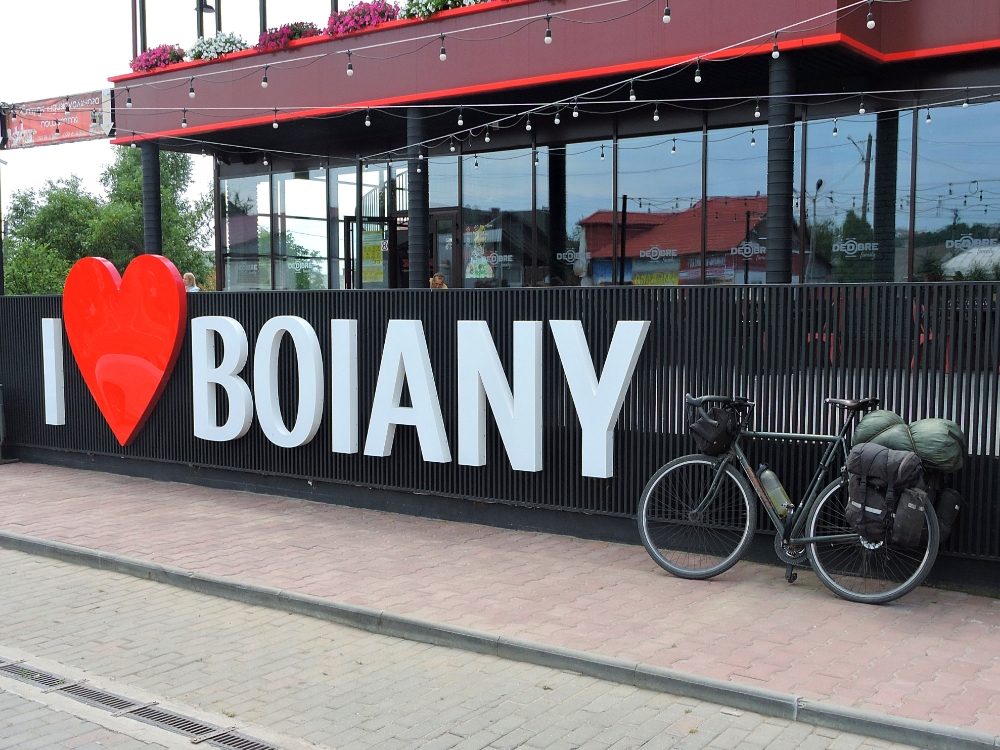Up to this point, all of the posts in the Origins series have focused entirely on the people from my father’s side of my ancestry. There were simple and practical reasons for that. My father’s heritage was primarily Western European, and essentially Colonial American, while my mother’s ancestry was exclusively Eastern European and her family arrived in North America only one hundred twenty years ago. Consequently, with the four-hundredth anniversary of the first arrival of my father’s ancestors just months away, at the time of this writing, and with the majority of his other ancestors arriving in the decades that followed, there have been ample opportunities for me to scour records that can be found relatively close to home and to develop theories to complete most of his family tree. On the other hand, the story of my mother’s family had been locked behind The Iron Curtain until relatively recently. That particular aspect is especially sad, since it meant that my mother never really had a practical opportunity to visit the land from where her family originated, and, in fact, I had also not been able to learn much about them until later in life. But the most basic reason that I have not mentioned them before now is that the World2 Tour had always been routed in a eastbound direction, and, therefore, Eastern Europe would be, by default, the last of the relevant places I would get to visit.
There is a positive factor in all of this, however, and that is that when one’s immigrant ancestors arrived fairly recently, and especially if they were people of meager means before relocating, there is a high probability that many generations of their ancestors lived in the same village. Once that location is known, therefore, the process of investigating that lineage is significantly simplified. In our case, we have always known the name and location of our point of origin. It was a village called Boian in the region known as Bukovina. Vasilie Gorda, his wife Domnica Demianciuc, and an infant daughter left there in 1899, on board a ship called Bulgaria, bound for Halifax, Canada. Another daughter was born a few months after they arrived, but my grandmother, Joanna Gorda, was not born until five years later. In 1901, Dumitru Matei and his wife Maria Moscaliuc followed, on the ship Assyria. With them were my grandfather, Mihail Matei, an infant at the time, and his two older sisters. In what I feel was a somewhat unusual circumstance during the emigration boom of the early twentieth century, these families, together with hundreds of other emigrants from Boian, settled together in the same place, a newly-formed village on the plains of the western Province of Alberta, one hundred kilometers northeast of the city of Edmonton. The new arrivals gave that place the name of their former home, Boian.
For most of my life, that was as far back as we could determine. There are a couple of books that contain firsthand accounts written by residents of the Alberta Boian, but most of those stories focus on life in Canada, with only little snippets relating to the earlier years in Bukovina. Another wonderful book was complied more recently containing many archival photographs of the original Boian in Bukovina, revealing it to have been a classically beautiful small European village of that era. However, as will be mentioned momentarily, the images contained within are not particularly relevant to that location today. In any case, none of these sources could provide any information that might help me identify any of my earlier ancestors.
A significant improvement occurred shortly after the turn of the century, when copies of the Metrical books from the Boian Orthodox Church were obtained by the LDS Family History Library. Several years later I borrowed those records on microfilm and made my own copies. Had I been a little more patient, I could have had an easier time, since digital versions are now freely available online. It was probably good that I didn’t wait, however, because extracting information from such old, handwritten documents, where a mix of languages was used, as well as a mix of alphabets and styles—Latin, Cyrillic, or often cursive Cyrillic—was always a laborious and slow process. Nevertheless, with patience, I was eventually able to uncover full, or partial, names and important dates for twenty-five previously unknown grandparents, and numerous aunts, uncles, and cousins. In so doing, I learned that I also had ancestors from families named Crocos, Grumeză, Guleota, Lazăr, Moscal, and Comarnitchi. All of my relatives from Boian are listed in the records with the label țăran, which translates to peasant.
The level of literacy among the residents of the original Boian was quite low in that era and therefore most didn’t particularly care what spelling was used when their names were recorded, a fact that further complicated matters. The records from the Church date back to only 1840, however, and so any of my ancestors who lived prior to the early nineteenth century will remain unknown, this time probably forever. Genetic evidence does suggest that in historical times parts of our ancestry were spread around the broader region, especially in areas like Poland, Russia, and the Balkans. Barring any great advances in that technology, however, our story ends in Boian.
Before continuing, a little history would probably be helpful. The earliest mention of a settlement called Boian in that region was made in the early sixteenth century. The name Boian derives from an old Romanian word boi meaning bulls
and the village site was a clearing where a man was known to keep his oxen. Bukovina means Land of Beech Trees.
So, Boian could certainly be said to have been a true cow town,
a fact my father would have made many jokes about, had he been aware. In those days Boian and Bukovina were part of the Principality of Moldavia, which extended through the modern areas of eastern Romania, southwestern Ukraine, and the country of Moldova, proper. During the First Partition of Poland an agreement was made that transferred Bukovina to the Austro-Hungarian Empire, which ruled the territory throughout the period when my known ancestors were there. Consequently, and unfortunately, this meant that when World War I arrived, Boian was directly on the front line between Austria-Hungary and Russia. In 1916 the Russians captured the village, burned it to the ground and deported its entire population far to the east, to locations in interior Russia. Some, but not all, would later return. At the end of hostilities, in 1918, Bukovina became part of the Kingdom of Romania, after a tense standoff between Romanian and Ukrainian factions in the region and the remnants of the defeated Central Powers. That status did not last long, however, and at the conclusion of the Second World War northern Bukovina, where Boian is located, found itself to be part of the Soviet Union, and its subunit, the Ukrainian SSR. In 1991, with the breakup of the USSR, that part of Bukovina transitioned smoothly to the independent nation of Ukraine. Today, the default spoken and written language in Boian is Ukrainian, however, throughout recent history most residents of Boian, including my ancestors, considered themselves to be Romanian, speaking the Romanian language and following Romanian customs (today, the spelling of place names in that region is frequently given in several variations depending on culture, politics, and which alphabet is being used. Here I will stick to Boian, and Bukovina, but there are a few other possibilities often seen.)
Fifteen years ago, along with my mother, an aunt, and a cousin, I visited the location of the second Boian in Alberta. I enjoyed that tremendously, but there were still many questions left unanswered. One in particular that I was interested in investigating was the nature and methods of travel that our emigrants undertook as they moved halfway around the World. After all, people, like me, who occasionally go on long-term, global journeys frequently pay attention to that sort of thing. Last year, during the first section of the Tour, I paid a visit to the Immigration Museum in Halifax, Nova Scotia, at precisely the point where my ancestors had first seen North America. Unfortunately, there were no remaining structures or exhibits there dating to the period around 1900, since the majority of immigrants to Canada arrived one or two decades later. However, this past February I found myself unexpectedly spending a little over a week in Hamburg, Germany, the port city from which they embarked on the Atlantic crossing portion of their journey. I wondered if there might be another similar Emigration Museum there, and, of course, there was.
I have since learned that to travel from Bukovina to Hamburg emigrants, even as early as 1899, would have been able to travel by railroad, departing from the Bukovinian capital, Chernivtsi, located just twenty kilometers from Boian. The most likely route would have taken them through Lviv (then named Lemberg,) Krakow, Wroclaw (then Breslau,) Berlin, and finally to Hamburg. So I will have seen all but one of the cities they transited through during the Tour. Along the way, they would have been required to stop for a period of quarantine at the Prussian border, which at the time was a short distance west of Krakow. They could not travel leisurely because schedules were important, and most emigrants would have pre-booked passage on a specific vessel, as opposed to simply turning up in Hamburg and taking the next available ship. Once there, they would have been processed through an Emigration Hall, like the ones in the image below. Those are located at their original sites, where the Museum in Hamburg now stands, and are reconstructions based on the original designs. There were eventually twelve Halls, packed into a very small area, though since their construction was only initiated in 1896, when the Gordas arrived only a few may have been ready for them.
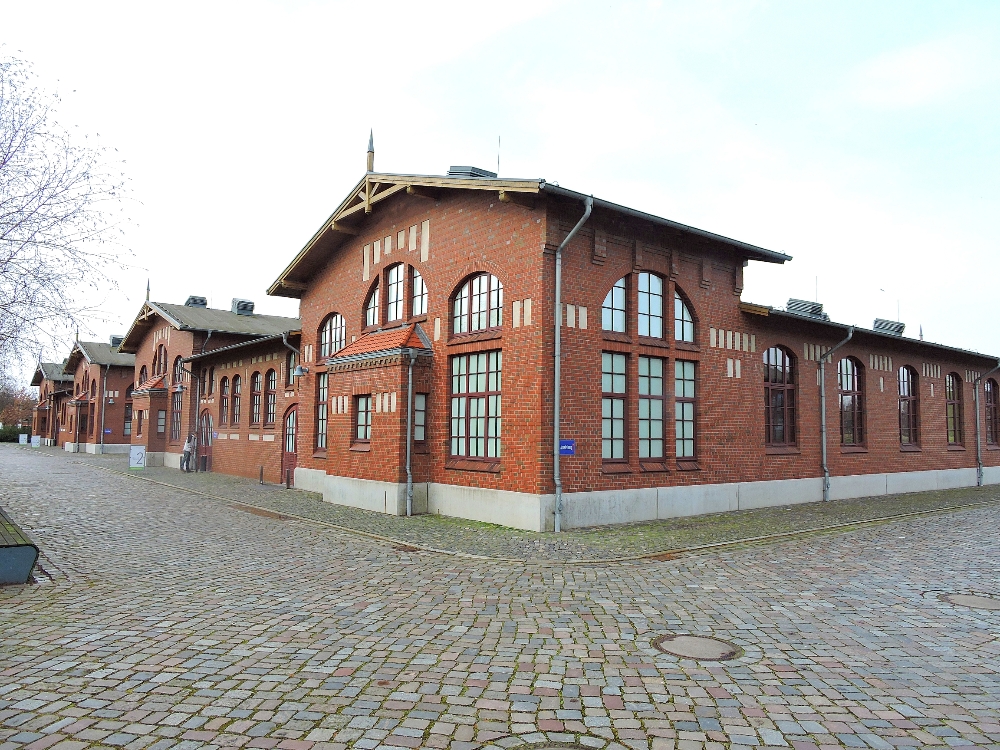
I have often wondered just how hundreds of țăran from Bukovina would have decided to relocate as a group to the unfamiliar, near-wilderness of Alberta, eight thousand kilometers away. At the museum, I saw examples of some of the promotional materials put out by the likes of the Canadian Ministry of Agriculture and various Canadian Railroads, made to entice potential immigrants. Personally, I probably would have wanted some first-hand experience, or at least a more trusted referral, before making such a move.
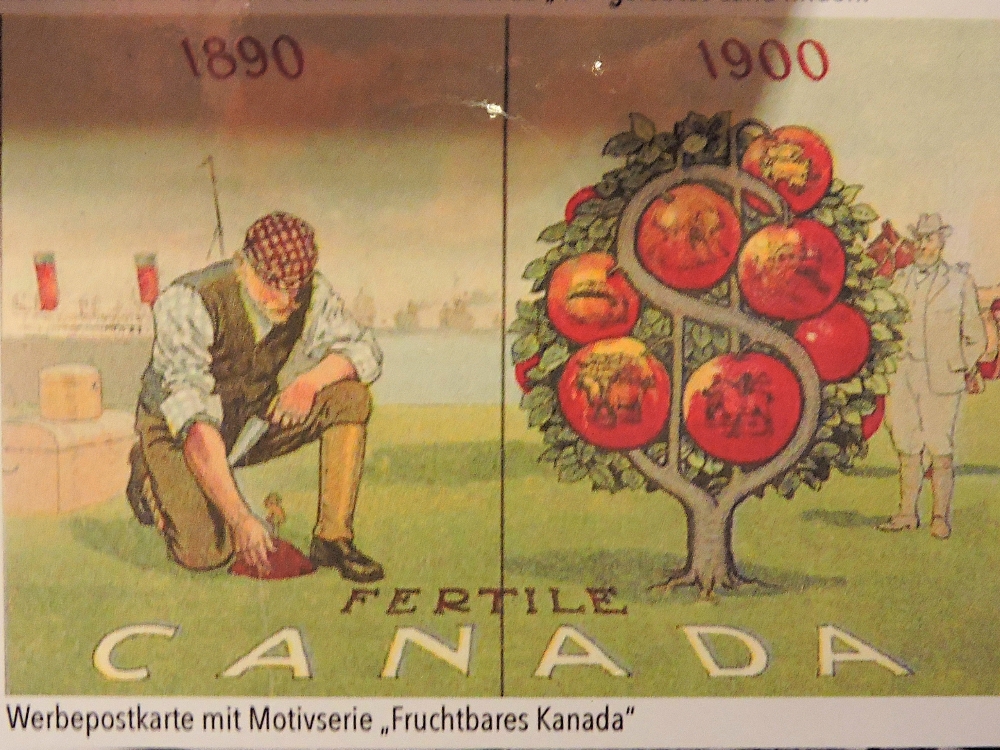
Fertile Canada
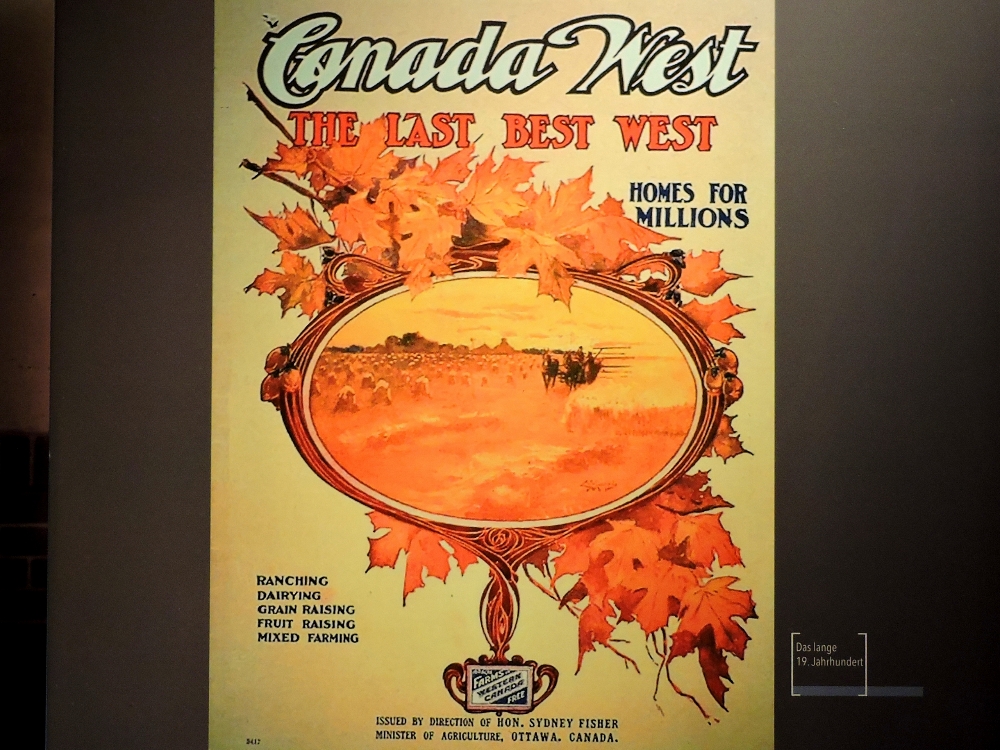
So, by that time, I had seen the new
Boian, the points of my ancestors’ disembarkation and embarkation, and a few intermediate points. The only thing left was to make a visit to their former home, the original Boian, itself. However, for much of 2020 well-known circumstances seemed to be conspiring to prevent me from doing just that. But I was persistent, since this was one of the points along the Tour route that I was determined not to miss. Finally, in the middle of July, I was in Ukraine and ready to make the short ride from Chernivtsi to the village on one fine morning. At first I felt anxious, as the road leading there was a wide and busy highway, not the type of thoroughfare I would have anticipated would lead to my ancestors’ little rural village. A few kilometers before arriving the road finally narrowed down to a more standard two lanes, but it couldn’t be said to be carrying less traffic and the surface was especially bumpy. Nevertheless, in a fairly short time, I was there. Boian!
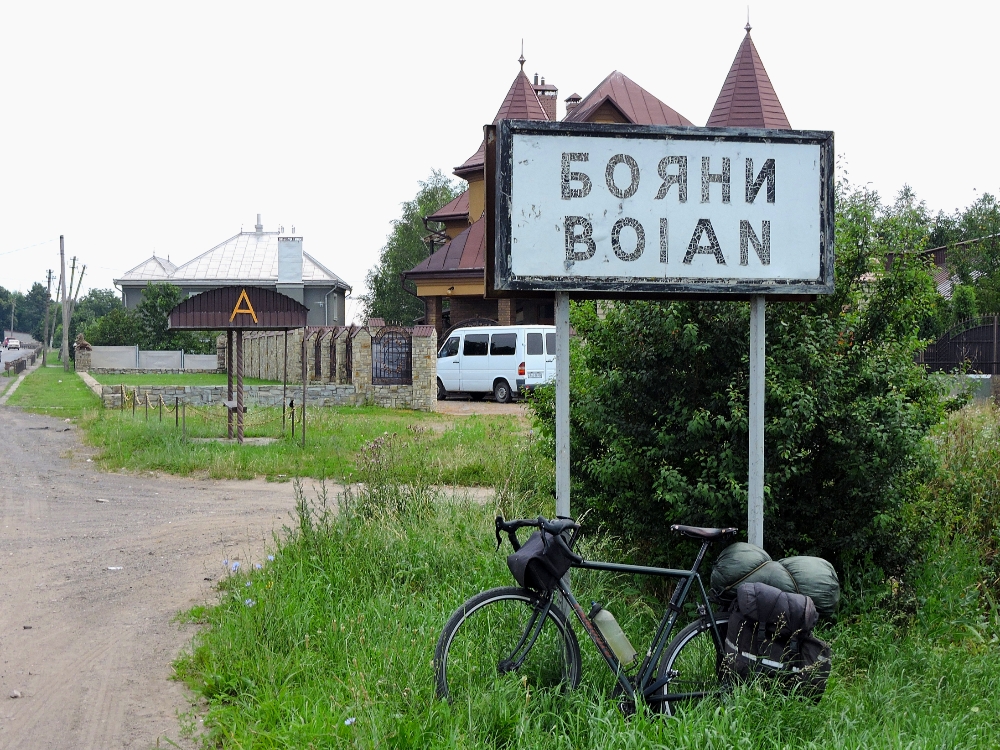
My only impressions of modern Boian before then had been gained by studying the Satellite and Street View images on Google Maps. In what has been a recurring theme for me lately, doing so had given me a rather inaccurate view of the actual place, as it exists now. The imaging tended to give me the sense of a little place that could soon dry up and blow away. However, in reality, Boian, which currently holds a population of around four and a half thousand, seems quite lively, even a little too noisy. The general impression is that of a typical highway town,
of which there are thousands of examples around the Americas, Asia, and Africa, consisting of a series of commercial buildings strewn along the edge of a highway, with homes placed farther back, and no real town center to speak of. However, in this case, that arrangement provides most of what the people living there need, a mid-sized supermarket, a couple of smaller ones, a hotel, a few restaurants, two hardware stores, a health clinic, a school, and several other small establishments. Topographically speaking, Satellite View had also skewed my preconceptions into thinking the village would be completely flat. In fact, on the north side of the highway the terrain is pleasantly rolling. To the south a flatter area leads down to the banks of the nearby Prut River, which is too small to be navigable, but large enough for the other benefits rivers usually provide. Overall, that part of Bukovina felt green and fertile, and in mid-July the days were sunny and neither too hot, nor too humid.
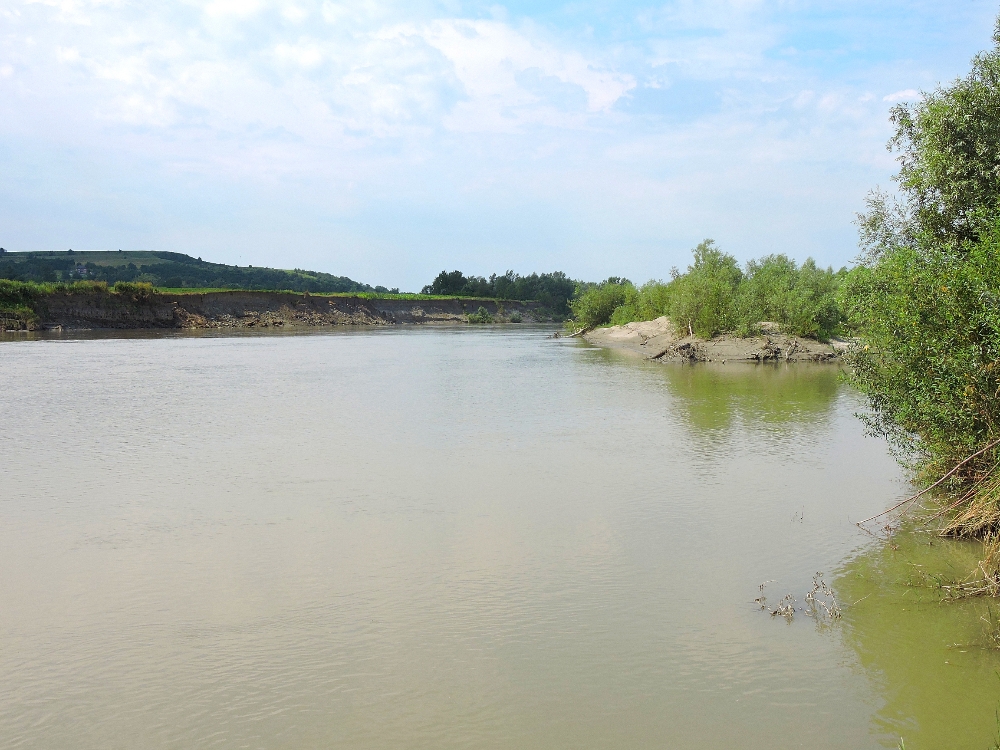
Around the World, many small towns seem to specialize in the production of a particular type of craft or manufactured item, such as stone carving or furniture making, and they frequently display their products along the roadside. In Boian that item seems to be large, metal driveway gates, and associated items. I cannot say with certainty that all the ones shown below were made there, but I did see one in the process of being fabricated, so at least some were.
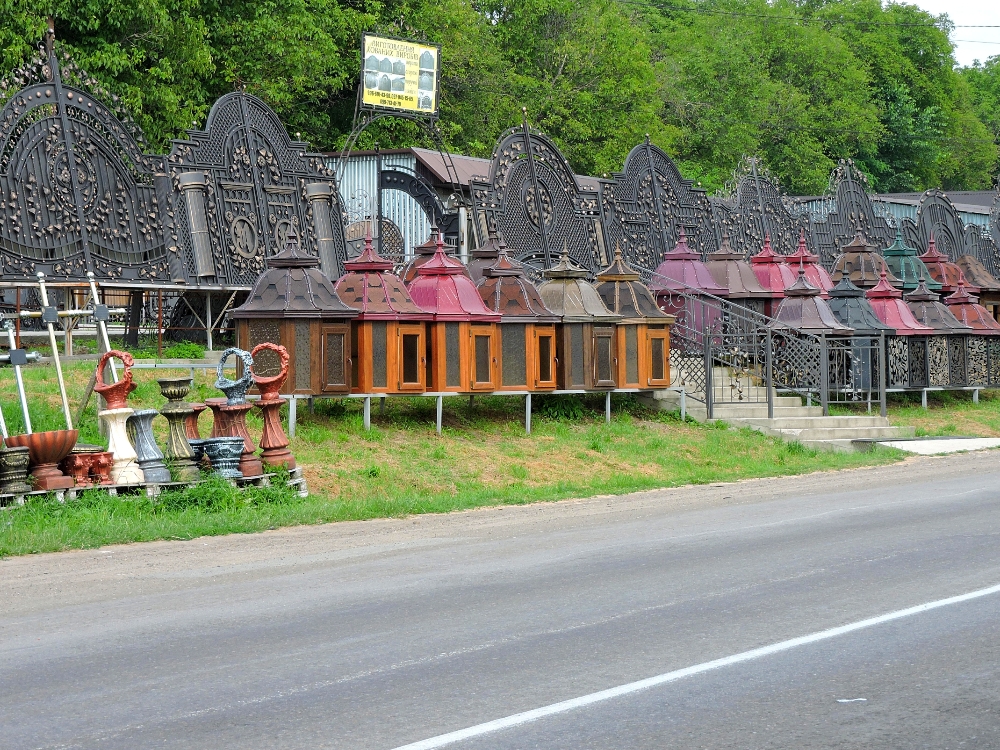
One observation that revealed a somewhat different past was a large building across from the hotel. It appeared to have been built, say, around the 1970s, when the situation in the town was substantially different, but also to have been sitting vacant for several years. The sign on the front states that it was a Cultural Center, and other postings indicate that at one point there was a library inside as well. On the front facade are some beautiful mosaics, showing that, in earlier times, despite living under a system with many strange and dysfunctional aspects, culture and beauty could occasionally be found, even in small places like Boian.
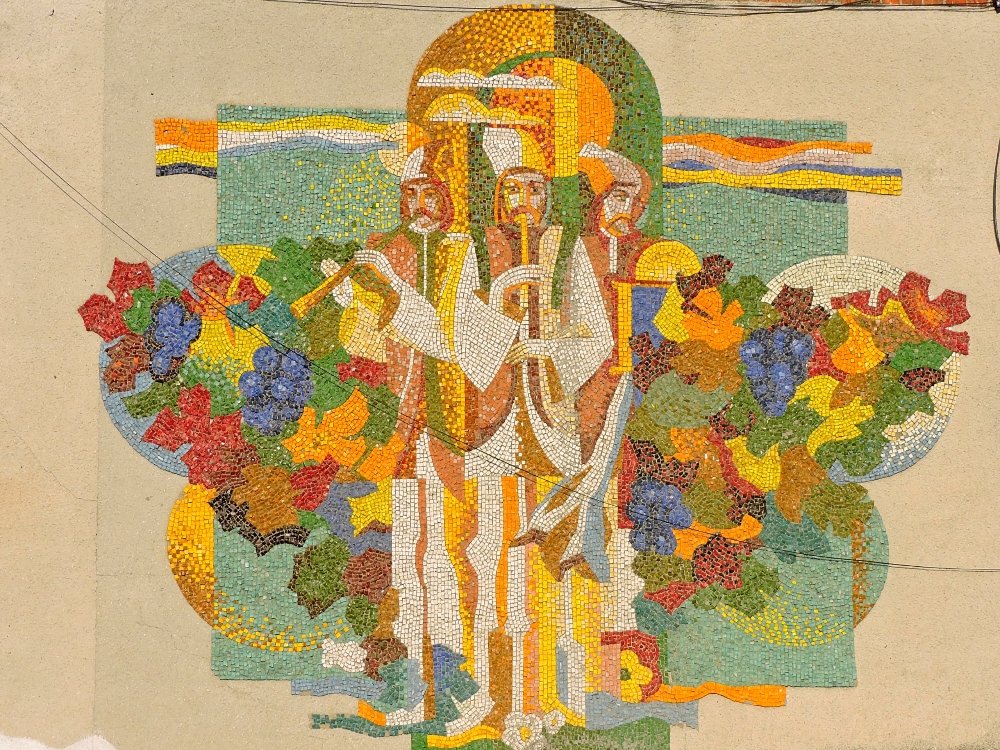
Nearby are a few monuments that also speak to difficult times in the past. One is a recently-placed stone that commemorates the one hundredth anniversary of the return of the deported residents in 1918, who then began to rebuild their destroyed town. Another unpleasant example, memorializes around a hundred Boian citizens who were Victims of the Stalinist Regime 1941-1953.
The only name I recognized was an Ilie N. Gorda, who was most certainly one of my distant cousins. The most prominent, however, is a large monument to Ion Neculce, who was born in the late seventeenth century. He married into a wealthy and powerful family, and because of that he eventually inherited ownership of the entire town of Boian. However, he was best known as a poet and a Chronicler of Moldavia.
Above his bust is a verse written by him that translates to:
What delusional masters you had!
What a fate for your life!
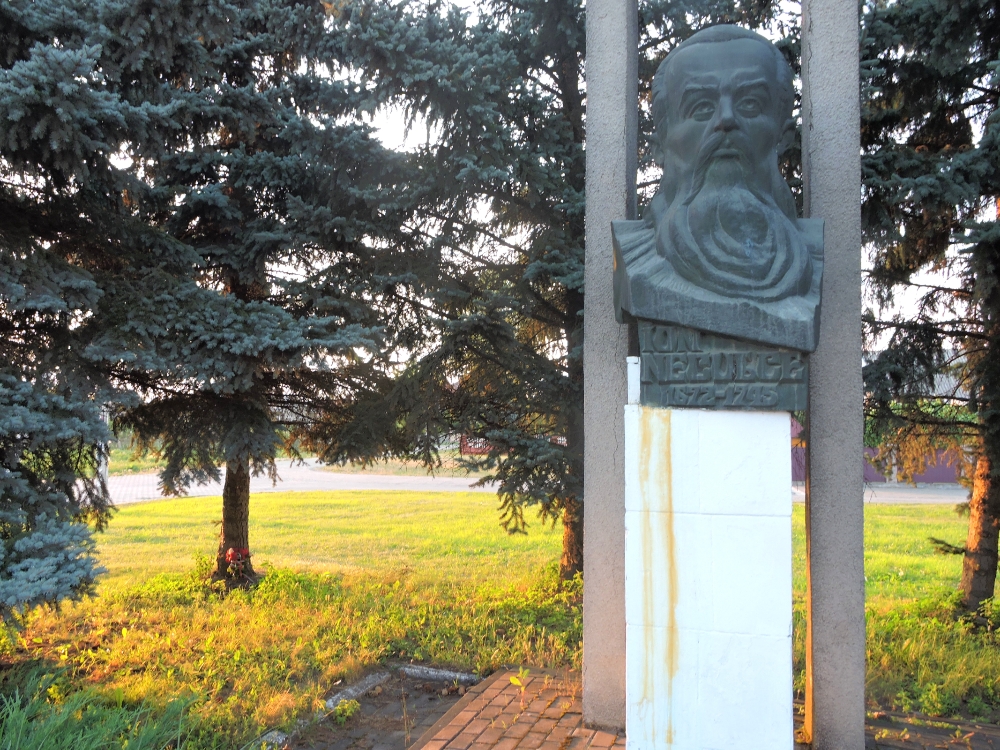
It is a extremely sad circumstance, for everyone involved, that the town was destroyed in 1916. In my case, that meant that there were no buildings or structures available for me to see that my ancestors would also have seen in their day. The closest thing was just a little farther down the road, namely the Assumption of the Blessed Virgin Orthodox Church, which was built in 1829, but presumably totally reconstructed after 1918. Whether it was rebuilt exactly as it had existed previously, or not, I cannot say. Nevertheless, this location was where all of my mother’s more recent ancestors were married, baptized, and where the records that eventually allowed me to identify some of them were kept.
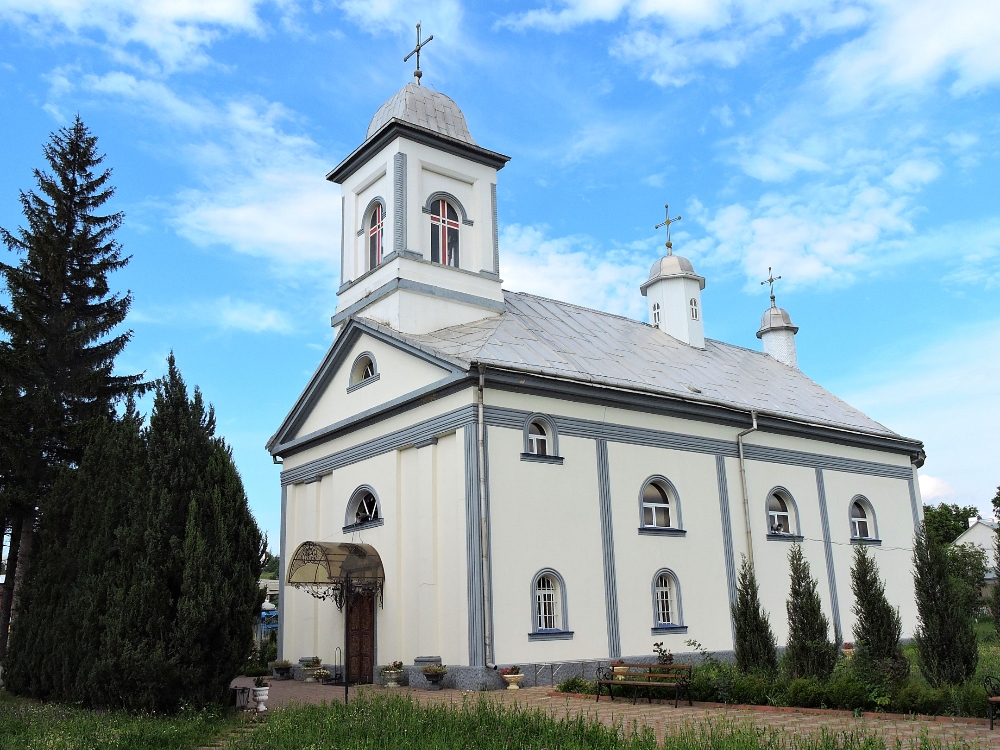
In the Churchyard stands this statue of the Priest Iraclie Porumbescu. He was a Romanian patriot, and was sent to Boian to shore up the Orthodox Church there, at a time when it was losing ground to others. He was also the father of the famous Romanian composer Ciprian Porumbescu. Though he only worked in Boian from 1857 to 1859, he was a man some of my ancestors would have known personally.
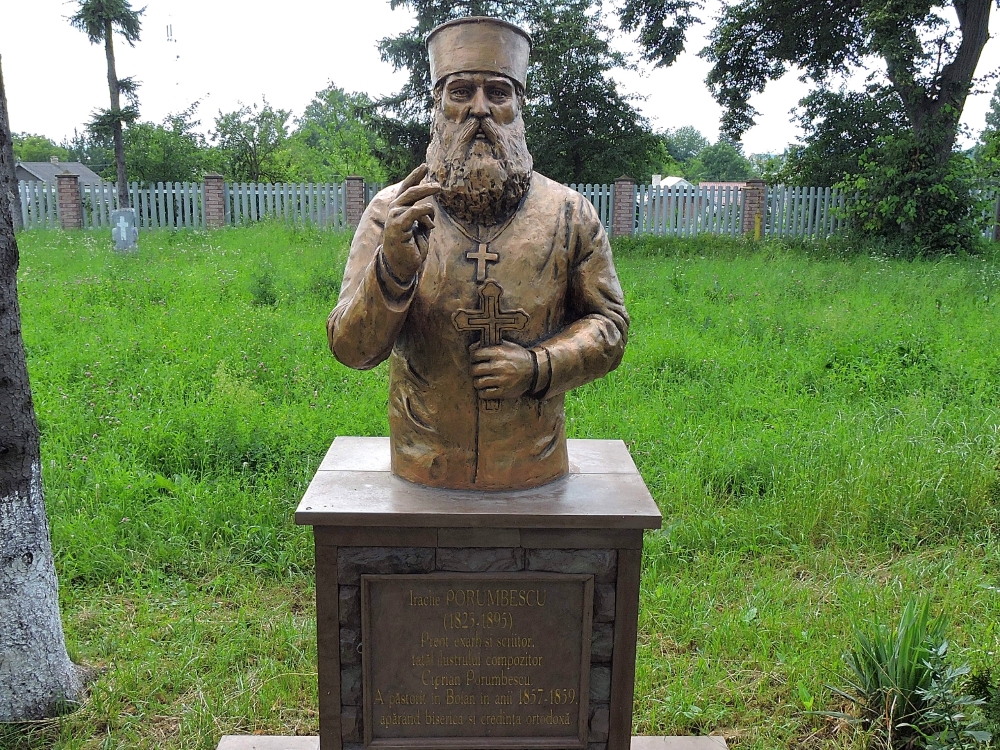
As it turned out, I was in town on a Sunday and on that afternoon, after some morning birding, I stopped by the Church again to take a few more photos in better light. There were a few men still hanging around at that time, so the doors were open and I was able to take a quick look at the interior. I should confess that I have never been a big fan of Christian religious art. That is probably because most examples that I have seen were from, or were influenced by, the stylistic periods from the Renaissance through the Rococo, and most of the people portrayed seem to be significantly miserable. I understand the reasons behind that, in relation to the overall mythology, but still. However, I find the art from the various Orthodox sects much more appealing, and the inside of the Church in Boian is undeniably beautiful, with many images of notable Saints, and other important figures from the past. The ceiling was especially interesting, since the central figure was painted on the base of one of the domes, which creates an interesting three-dimensional effect. The men told me that at least some of the art was original,
though I am not quite sure what they meant by that. It is certainly possible that there were indeed some older pieces there that had been safely stashed away during wartime.
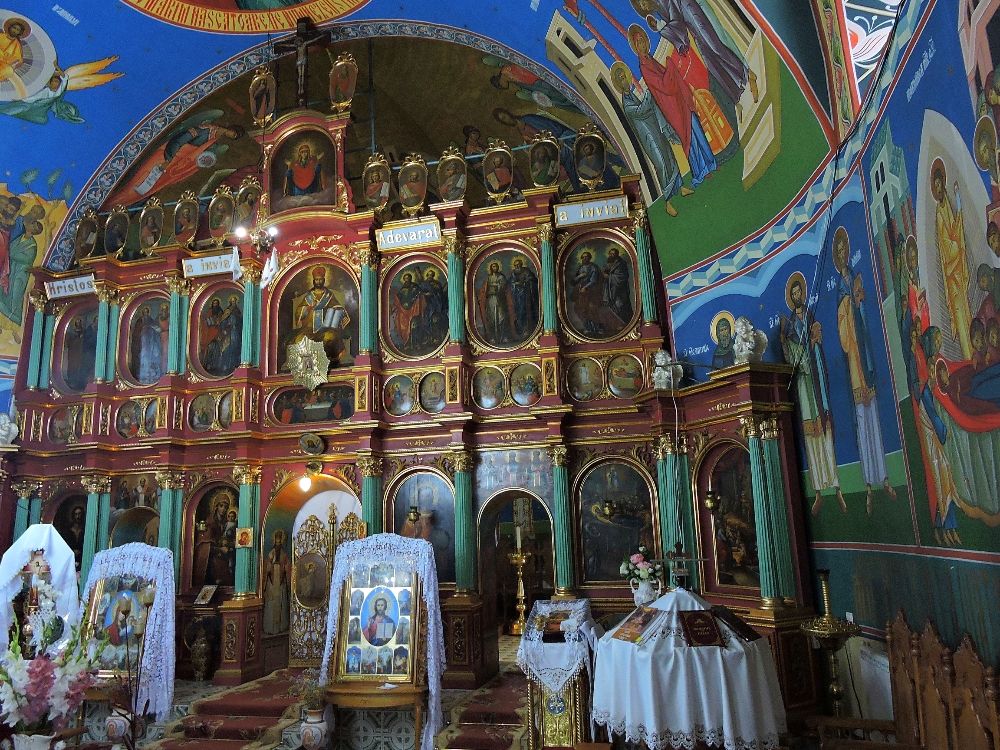
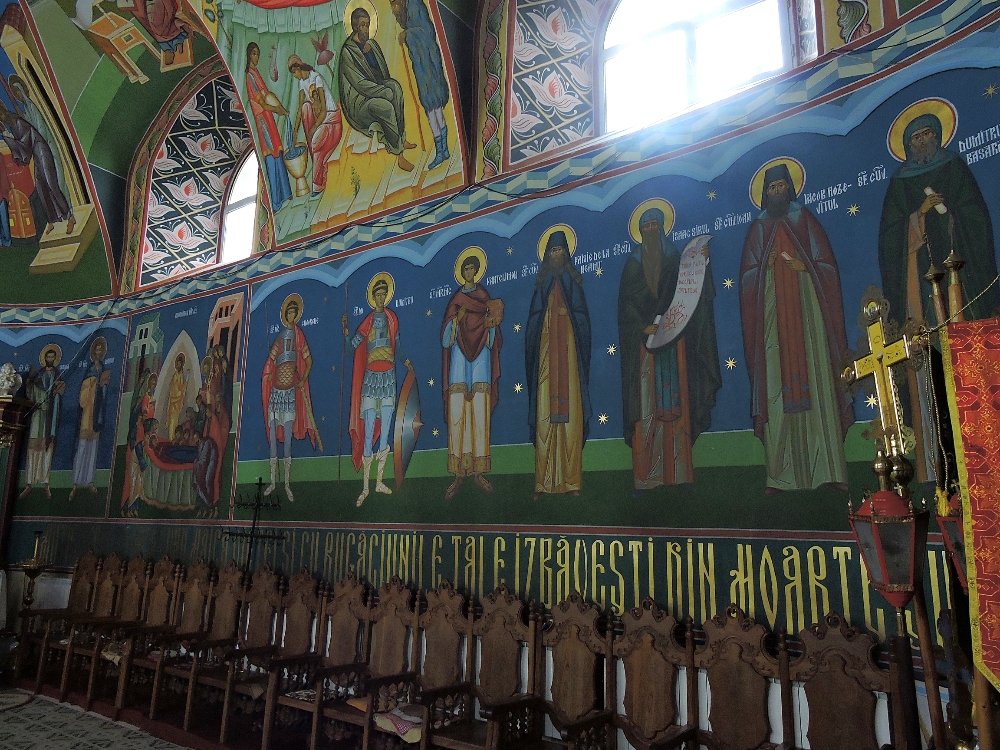
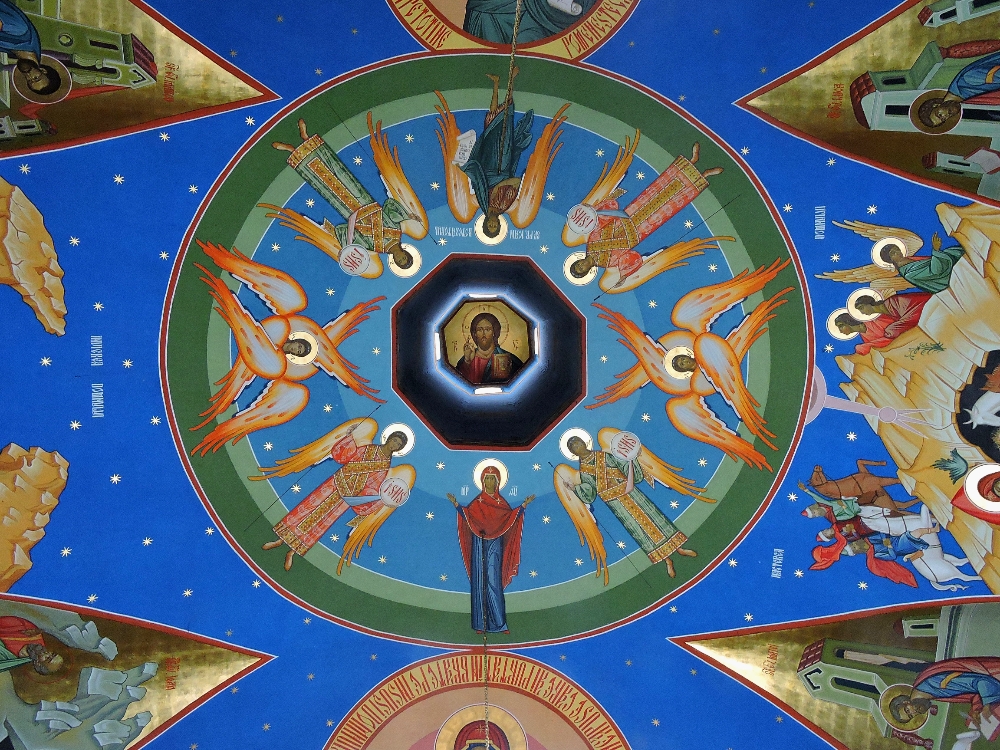
I have to say that had I only ridden through town on the highway, like I do with so many similar towns during a tour, I probably would have left feeling slightly disappointed. Fortunately, I spent the better part of a day taking a long walk through the parts of town located away from the road, where all the residents live, and that raised my opinion dramatically. Not all the residents I encountered were humans, as it turned out, as the two White Stork chicks below can attest. I was pleased in Sweden when I made distant observations of White Storks, what I thought a Life Bird, until I remembered that I had previously seen that species fourteen years earlier, in South Africa. I should have been even less excited then, because essentially every town and village in Eastern Europe has one or more giant stork nests, like this one. It has been fun, over the last month, to watch the various chicks rapidly change from smallish downy fuzz balls to nearly full-grown birds. In this part of the World it’s easy to see how the story of storks delivering babies might have originated.
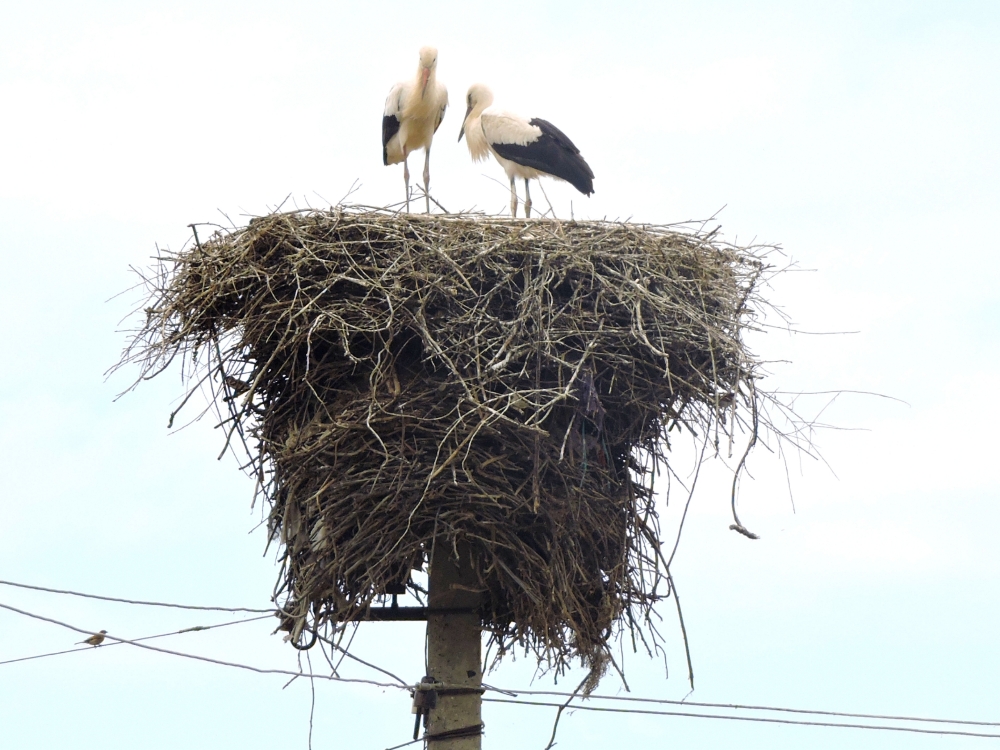
During my stroll I happened upon this group of men carrying banners and bags of food, heading in the opposite direction with dispatch and determination. A smaller group of babushkas followed behind them, carrying only food. They were obviously heading for one of the churches, but which I am not sure.
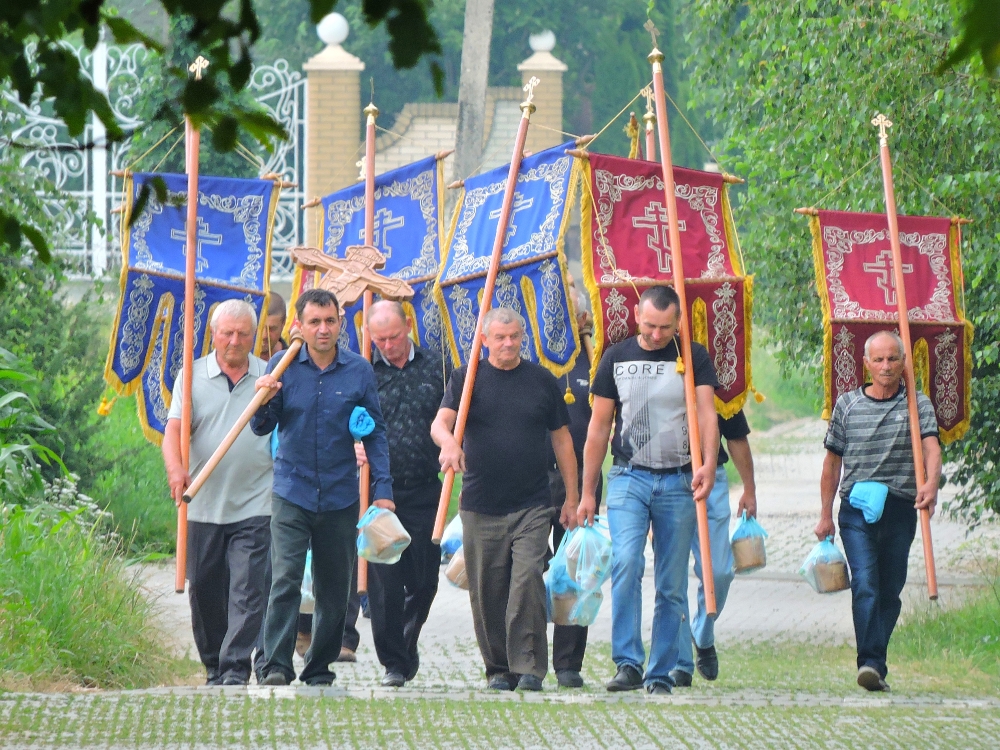
Something that I noticed right away, which pleased me greatly was virtual absence of ridiculous manicured lawns surrounding people’s homes, one of my least favorite aspects of towns today. Instead, well cared for gardens took their place, many filled with a nice selection of vegetables and fruits. Beans, squash, grapes, tomatoes, potatoes, and apples were all coming along nicely, to name just a few of the products. Towards the edge of the residential area larger farms began to appear, but they also made efficient and appropriate use of available space.
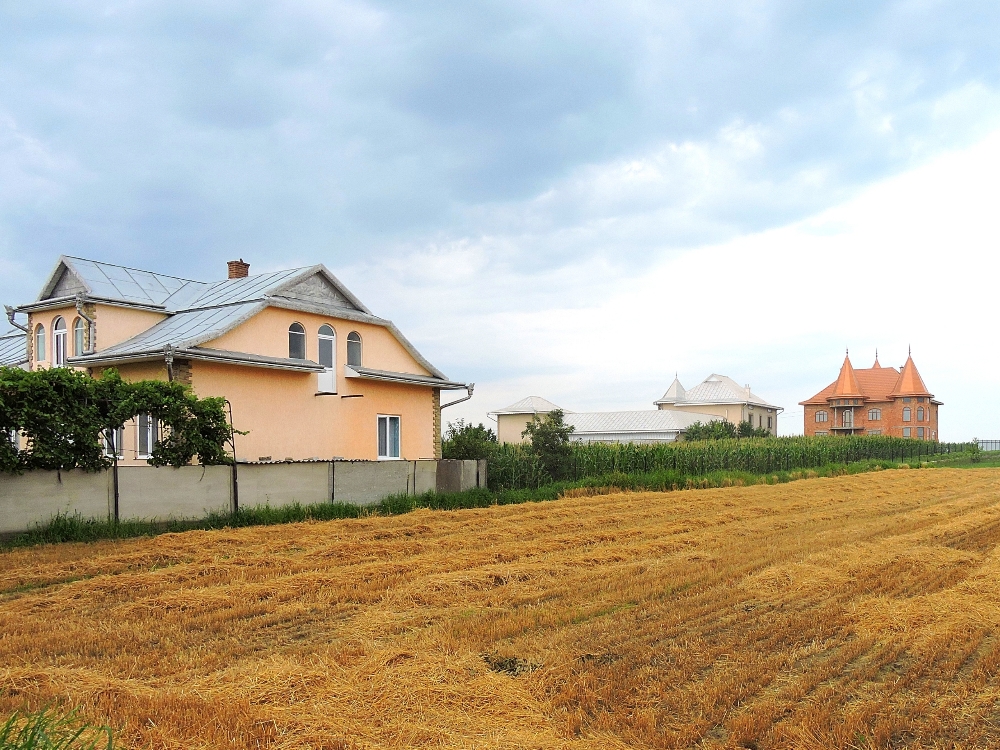
The men I passed earlier might have been heading for the Convent in Honor of the Boian Icon of the Mother of God. My ancestors would not have known about that particular structure, since it is only twenty years old, but is now a standout landmark in the center of the residential part of the town. Replete with impressive mosaics on its exterior, its blue walls and shining golden domes can be seen from many vantage points around the town.
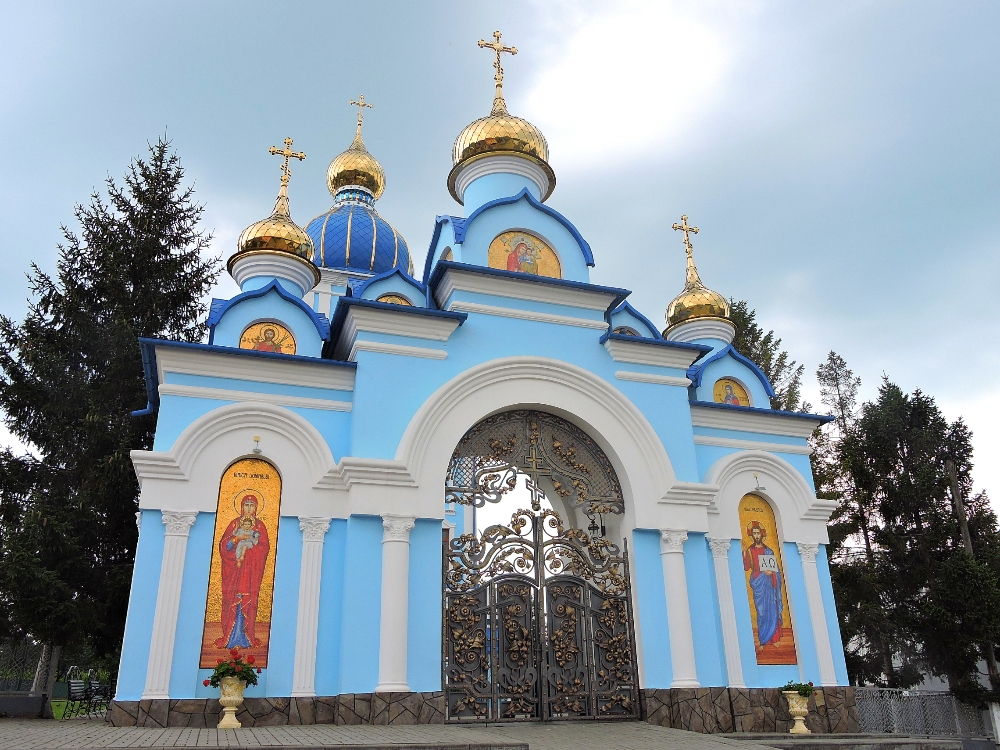
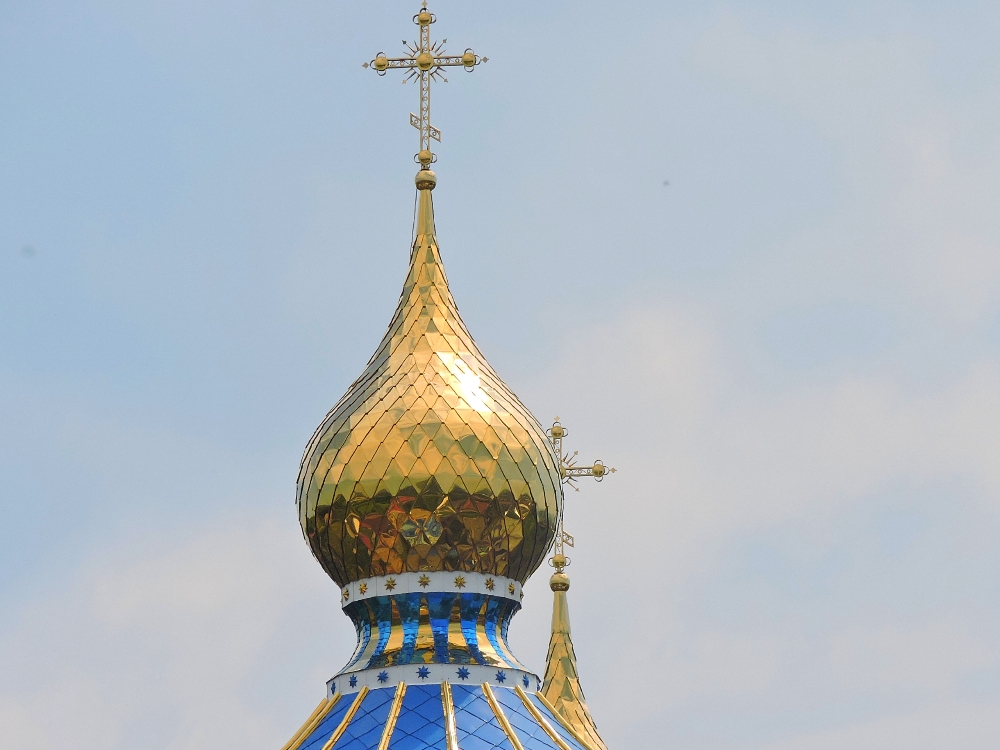
Readers of some of my other posts may have noticed how frequently I comment on architecture and urban design, or, more precisely, on how horrible most contemporary examples of those things are in many parts of the World. This is an especially egregious circumstance when one considers that we are certainly capable of doing so much better. Consequently, I was ecstatic to see that the neighborhoods of Boian check so many of the boxes that signify, for me, a nice place to live. I have already mentioned the lack of lawns, which is a great start. Along the same line is that a minimal amount of space has been sacrificed for the movement of vehicles around the neighborhoods, and, though they are indeed increasingly present, the result is a relatively quiet environment that is pleasurable to walk through.
The homes themselves exhibit their own set of nice characteristics, starting with the fact that almost every example is essentially unique, not as if it had been chosen out of a limited catalog. Many are surprisingly large, but all are proportioned based on good design principles. Adequate care and maintenance seems to be the rule, and even the older examples appear to be in good condition. Another situation that I find appealing, and have seen before in a few other places, is that when a new home is built the construction may take place over many years, and the owners may not be put off by living there before its finished,
thereby minimizing the large debt burden that might otherwise be necessary. Overall, however, the most appealing aspect may be the extensive use of ornamentation, a design component which has almost totally disappeared elsewhere. One of the most popular examples is galvanized steel sheeting, used for roofing, fencing, or similar applications, and which has been stamped with elaborate designs, as shown here.
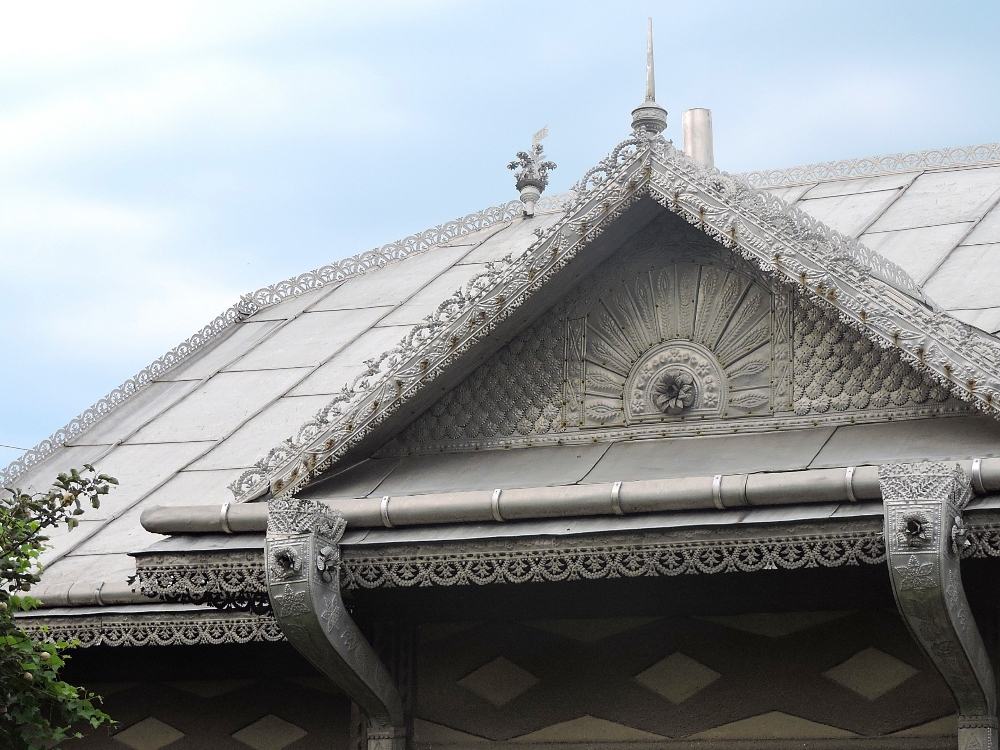
I was also quite fond of the artistic details painted, or sometimes created using raised reliefs, onto the exterior walls of houses. A few examples appear below. I am not sure if the motifs are Romanian, or Ukrainian in origin, but to me it doesn’t matter much.
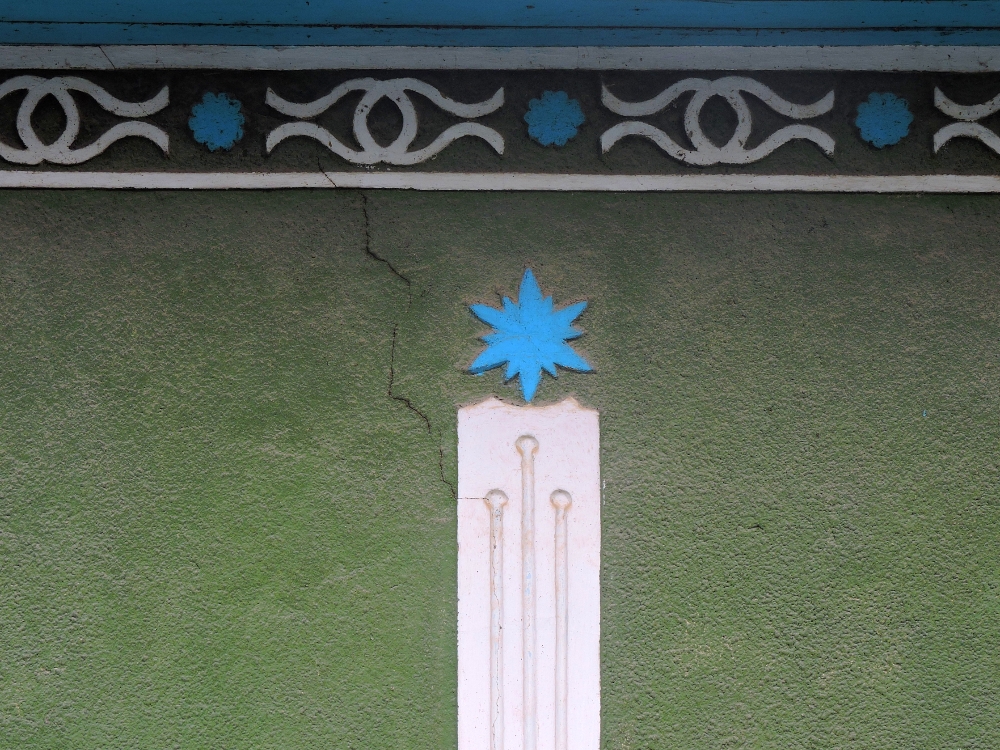
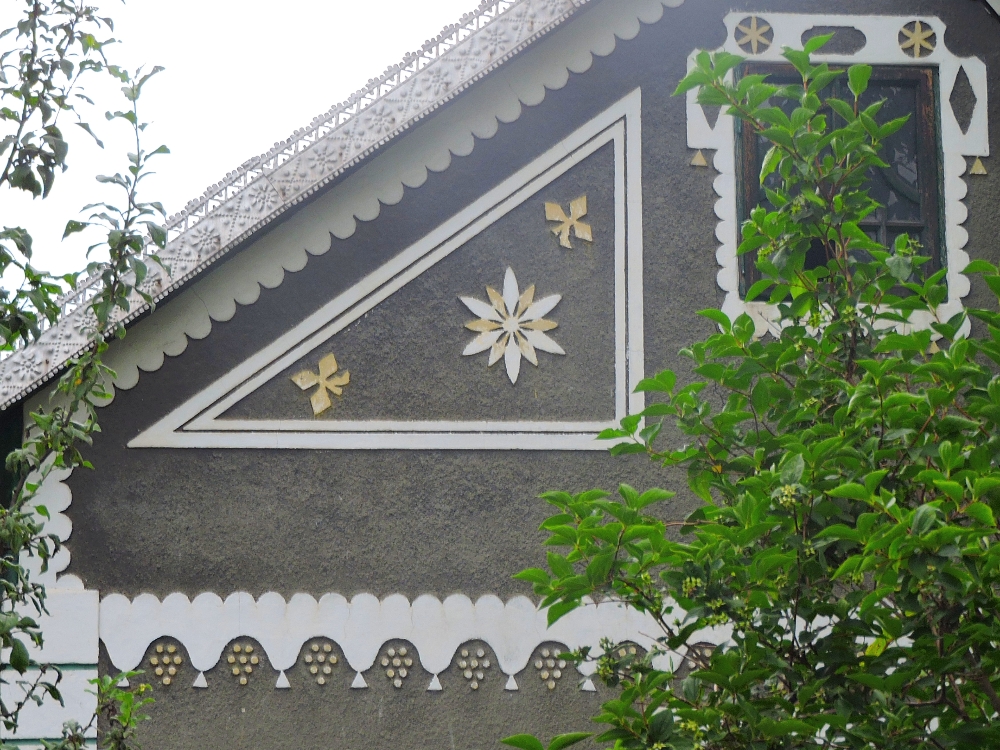
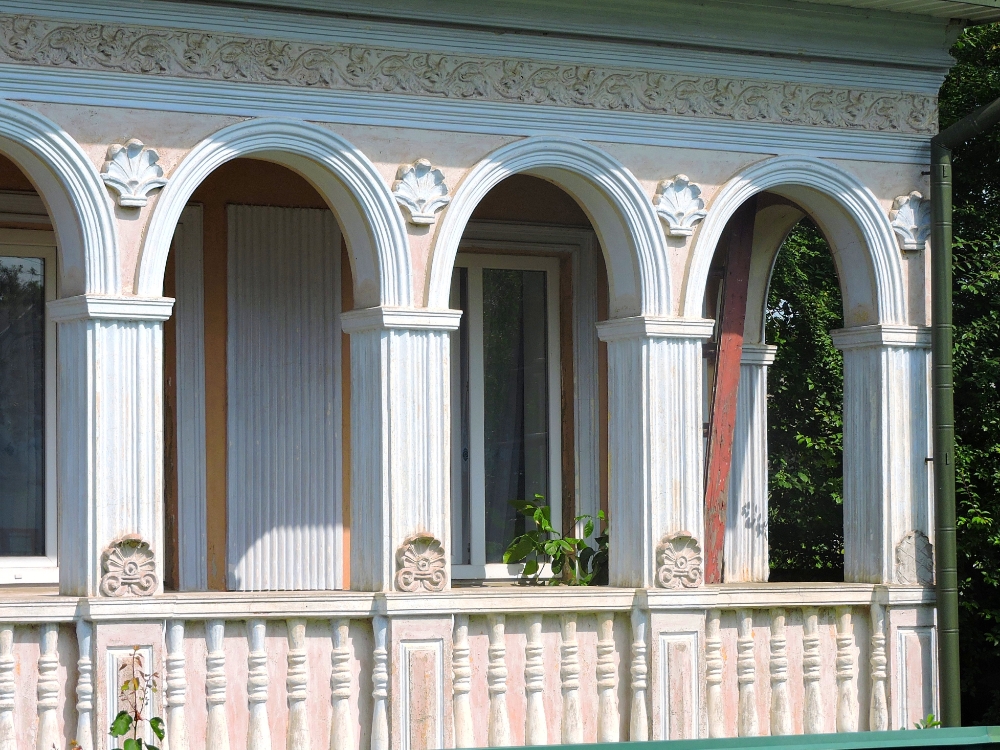
I also soon discovered what the other large items that I had seen sitting with the metal gates along the highway were. Well heads. It is apparently the case that municipal water does not reach most homes, so wells, both private and communal, are common. Not surprisingly they also appear with various levels of decorative flourish, as in these two examples.
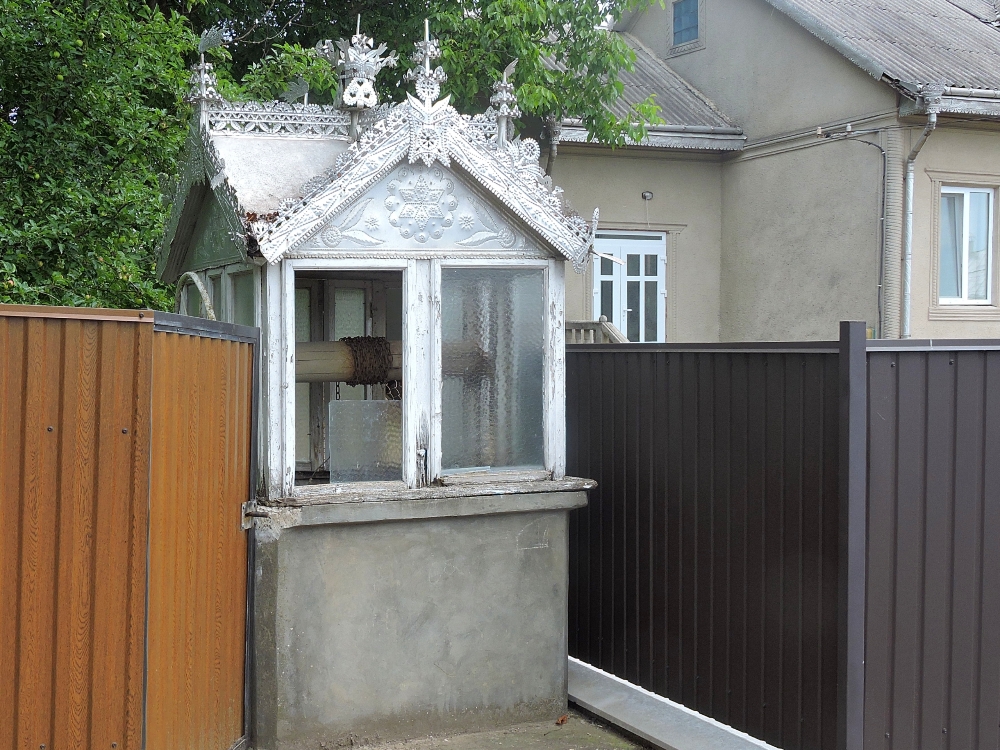
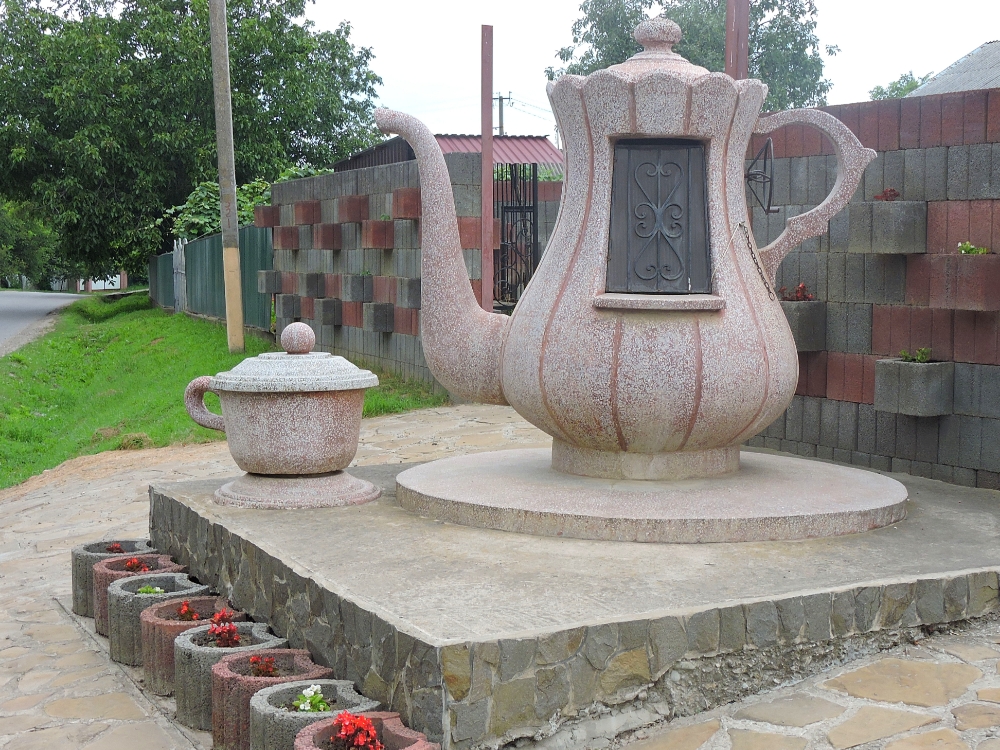
I absolutely enjoyed my stroll through the picturesque home village of my ancestors on that day. Who wouldn’t enjoy spending their time in a place where scenes like this one present themselves frequently.
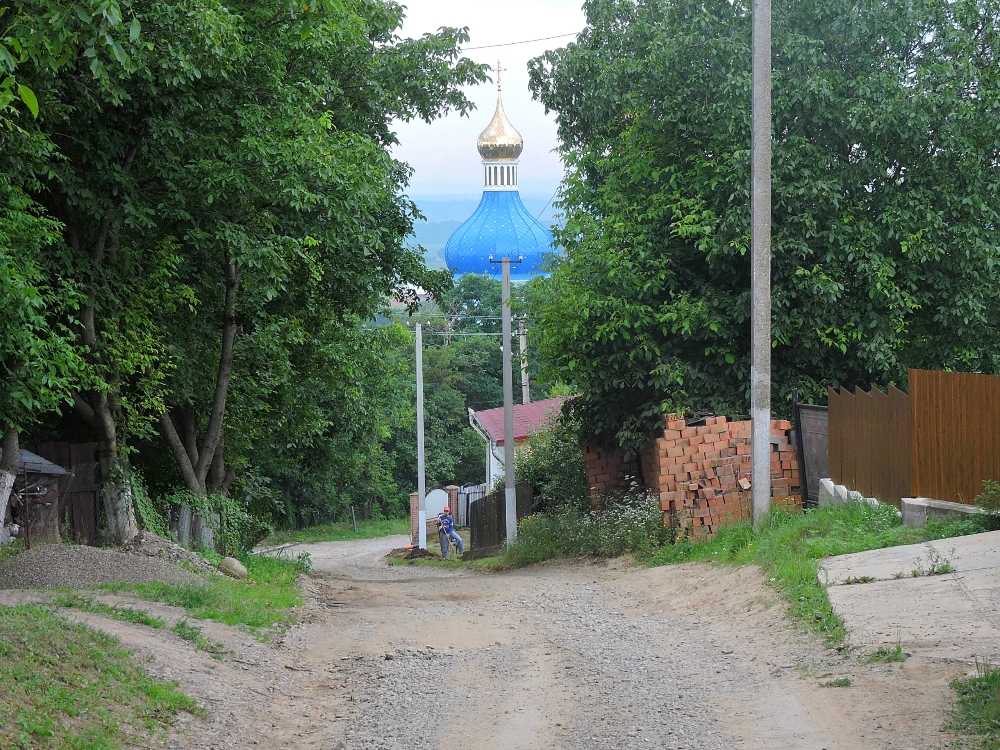
I had three and a half days to visit the town, though due to rain I extended my stay for one more day, although I slept through that extra day, instead of starting to write this post, like I should have done. This was adequate for a general visit, but, given my inability to speak either Ukrainian or Romanian, I did not have enough time to try to track down any people living there who might be distant cousins of mine. I did relate my story, as best I could, to several people, who all seemed at least somewhat interested. However, given that Boian has been a rather endogamous community for a fairly long time, I am most likely distant cousins to the majority of people living there today, at least those who hadn’t relocated there from another region during the twentieth century. Of course, identifying how I might be related to a random townsperson would likely be an unreasonable goal.
However, I did attempt another tactic that I thought might be interesting. On my first afternoon there I spent a couple of hours wandering through the village cemetery to see if I might find some family members interred there. At first, success seemed unlikely. Older graves were only marked with a plain metal cross, and there was no apparent organization to the layout with old and new all jumbled together. However, it seems to have become a trend in recent decades to place an image of the deceased onto their marker, either by painting or etching, so that gave me a little additional motivation to keep looking. After a while I actually did begin to encounter some people with the family names I mentioned above, which actually gave me a slightly unusual feeling.
At one point I met a man, with whom I attempted a brief conversation. He said that there were many Moscaliucs present, and that off to one side I could find some Gordas. I did eventually stumble past a Moscaliuc, but never did find the Gordas he had directed me towards. No matter, since on my way out I accidentally came across the monuments for Vasile Gorda and his wife, Agrepina. As it turned out, I already had entered Vasile in my Family Tree, based on my earlier scans of the Church records. He was my first cousin, twice removed, and now I know what he looked like. Actually, I can’t honestly say that I can see much of a family resemblance, but he seemed to have been a striking fellow, and that hat did him well.
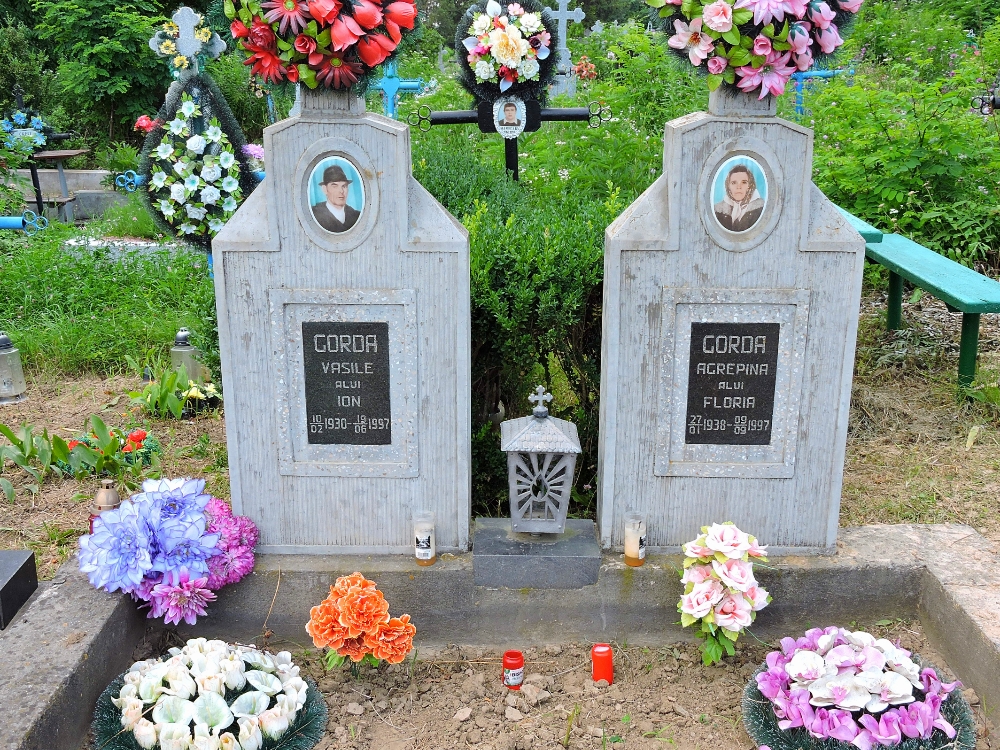
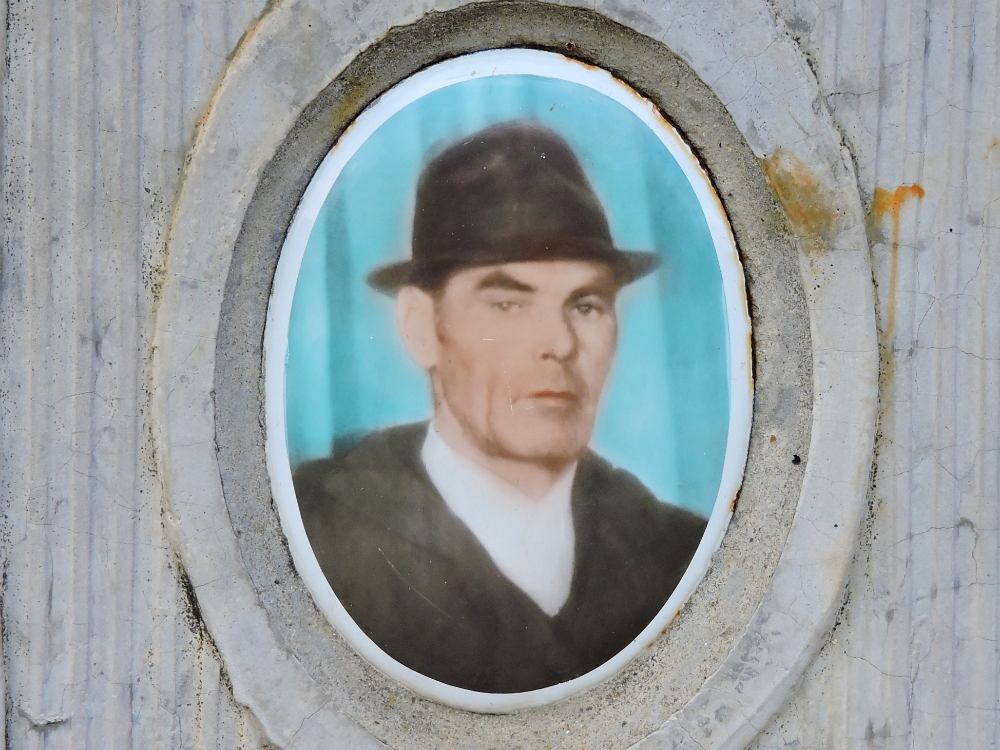
However, it was another monument that sent me reeling. Not far away was the marker pictured below. The first thing that jumped out at me was the name Mateй. My mother’s name at birth was Rose Matei, so anyone from Boian also having that surname was of great interest to me. (In this case, the name is written in Cyrillic. The first three letters correspond directly to the Latin alphabet, E is similar to the same letter in non-English languages, and й transliterates as yu.
In Romanian and Ukrainian Matei, or Mateй, is equivalent to the English name Matthew.
Locally, the name is pronounced like mat-EH, with the second syllable sounding just like a Canadian would say eh
at the end of a sentence, and the й only occasionally being pronounced at the end as a very soft schwa sound.) The full name I saw before me transliterates as Maria Andreievna Matei.
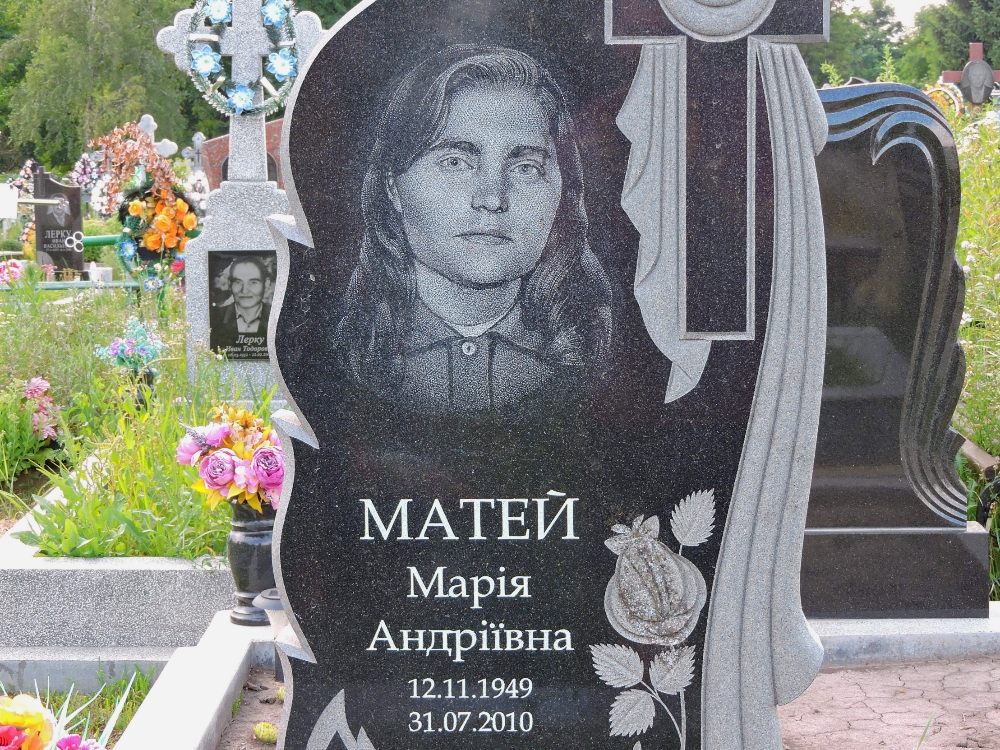
Almost instantly, my attention drifted over to her image, and I was struck by her shocking resemblance to my late mother, in her younger years. It’s true that Rose wore her hair short for most of her life, but I would recognize that face anywhere. For a long time, I stood there slack-jawed, trying to come to terms with what I was seeing. Then some uncertainty began to creep into my thoughts. She was interred in a two-space plot, half of which was still empty. Perhaps Matei was her husband’s name, and we weren’t actually very closely related after all (of course, there was still that idea that I am related to everyone in Boian in one way, or another.) To make matters worse, Maria lived too recently to appear in the available records, so I could never know for sure. By the time I was ready to leave Boian for good, I still had not uncovered anything about this potentially heartening relationship.
Then the next day, while I was cycling northwards, an interesting idea came to me, as occasionally happens in such situations. In Slavic societies, men are usually given a patronymic name as a second name, so, for example, the second name Ivanovich would mean son of Ivan.
I began to ponder Maria’s unusual second name, Andreievna, and wondered if a similar case applied to girls as well. A few quick searches later that day confirmed that suspicion and revealed that -evna was the suffix most commonly used in such cases. Therefore, she was, in effect, Maria, daughter of Andrei, and so then I had something to work with. I spent the rest of that evening searching through the online Church records looking for all the boys named Andrei, born between 1909 and 1929, who could have been Maria’s father. Fortunately, there were not very many with that name. However, there was also no one named Andrei Matei born during that time, so it seemed certain that Matei was her name through marriage.
What I did discover, however, was just as interesting, namely a man born in 1919 named Andrei Demianciuc. I was able to trace his ancestry back to a common ancestor with me, my third great-grandfather, Iakob Demianciuc. If Andrei was indeed Maria’s father, and I am now convinced that he was, she would have been my third cousin, once removed. Additionally, I found that one of Maria’s grandmothers was a Comarnitchi. So far, I could only locate one generation further back on that line, but that was a rather uncommon name in Boian, and so it likely does lead back to the Comarnitchis in my tree, which would make us double cousins This potential relationship now makes perfect sense to me, for I have always thought that my mother much more closely resembled her maternal grandmother, Domnica Demianciuc, compared to her grandmother on her paternal side. But what a strange coincidence it was, if indeed Maria did marry a man named Matei! Sadly, Maria Matei died too young. If she had survived longer, I could conceivably have met her during my visit. Then I might have learned whether she had the same light blue eyes, the same laugh, and the same mannerisms as my mother did. Unfortunately, time and distance too often prevent us from knowing such things, however.
Back at the Boian Orthodox Church, there is a small secondary Chapel, detached from the main building, which is decorated with more images of Saints, including the one below, showing Saint Archangel Mihail. As I mentioned before, my grandfather was Mihail Matei, so even though Mihail was one of the most popular names for boys in Boian at the time, right up there with Dimitrie, Ion, and Vasilie, it is possible that this image, or one just like it, was the inspiration for my grandfather’s name. Since I was, with absolute certainty, named after him, it may be indirectly responsible for my name as well. In most other instances, Archangel Michael is depicted as a warrior, battling the forces of evil, however, here he is seen with a more peaceful, even contemplative, countenance. I approve of the image.
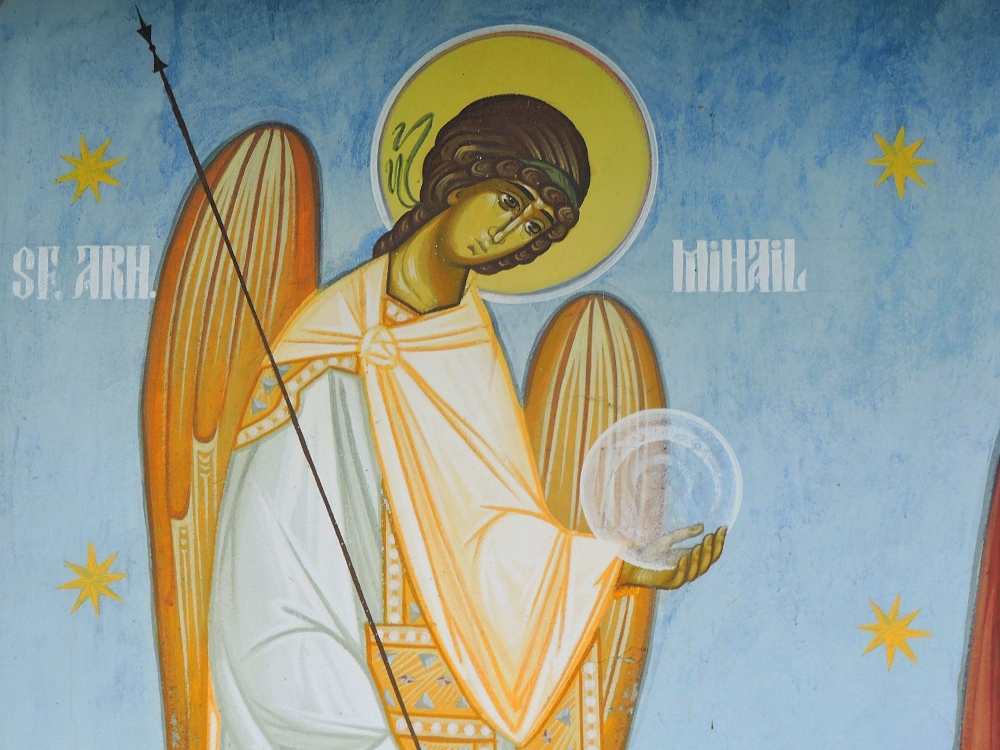
I also approve of Boian. This is the final installment of my Origins series, because I have finally run out of places to visit. Just as with previous cases, here, I am again struck by the fact that my ancestors lived in some very beautiful places. And then they left. In some of the other instances that led me towards some thoughts akin to regret. However, in this case that move may have been for the best. The emigrants who left their homes and crossed the globe had to struggle and sacrifice to build a new community from scratch in the wilderness, but they did so in peace. While, not quite two decades later, those who remained saw the town they loved destroyed and themselves forcibly ripped away from their land, only to return later to rebuild it again, from scratch. Today the original Boian remains a small, but flourishing, community much as it has been for centuries. The people who founded the new Boian succeeded as well, but the town they created did not endure for long. Instead, their descendants dispersed far and wide, now living throughout North America, and the World beyond, but always keeping with them the knowledge of the two little villages with the same name. Both of these are favorable outcomes, and so the final image sums up my opinion fairly succinctly, and that applies to both the new Boian, as well as the old Boian.
